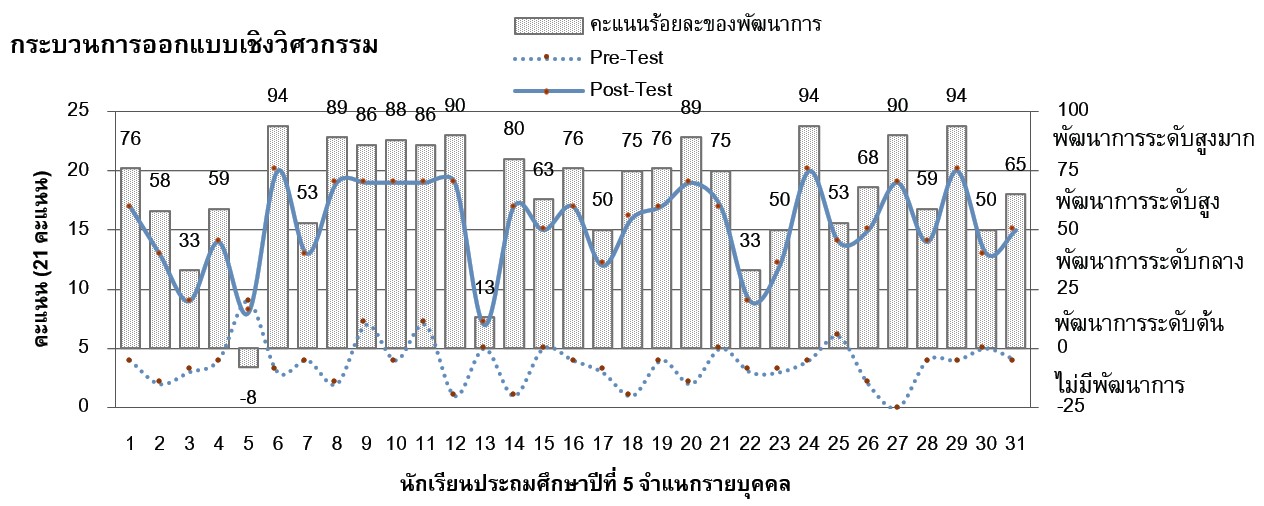การพัฒนาหน่วยการเรียนรู้บูรณาการสตีมศึกษาผสานหลักปรัชญาเศรษฐกิจพอเพียงสู่ชีวิตและอาชีพสำหรับนักเรียนระดับชั้นประถมศึกษาปีที่ 4–6
Main Article Content
Abstract
Artitaya Jituafua
รับบทความ: 12 พฤษภาคม 2563; แก้ไขบทความ: 29 สิงหาคม 2563; ยอมรับตีพิมพ์: 28 กันยายน 2563
บทคัดย่อ
การวิจัยนี้มีวัตถุประสงค์เพื่อ 1) พัฒนาหน่วยการเรียนรู้บูรณาการสตีมศึกษาผสานหลักปรัชญาเศรษฐกิจพอเพียงสู่ชีวิตและอาชีพสำหรับนักเรียนประถมศึกษาปีที่ 4–6 และ 2) ศึกษาประสิทธิภาพและประเมินผลการใช้หน่วยการเรียนรู้ ระเบียบวิธีวิจัย ที่ใช้คือการวิจัยและพัฒนา ดำเนินการวิจัย 3 ระยะ ได้แก่ 1) ศึกษาข้อมูลพื้นฐานการพัฒนาด้วยการสัมภาษณ์เชิงลึกผู้มีส่วนเกี่ยวข้อง รวมถึงสำรวจความคิดเห็นและความต้องการของนักเรียน 2) พัฒนาหน่วยการเรียนรู้ 3) นำหน่วยการเรียนรู้ไปใช้และประเมินผลกับนักเรียน 98 คน ข้อมูลเชิงปริมาณนำมาวิเคราะห์ทางสถิติ ข้อมูลเชิงคุณภาพนำมาวิเคราะห์เนื้อหา พบว่า กิจกรรมวิทยาศาสตร์ที่ผู้เรียนต้องการสอดคล้องกับลักษณะการจัดการเรียนรู้ตามแนวทางสตีมศึกษา หน่วยการเรียนรู้มีประสิทธิภาพ 81.76/83.54 ตามเกณฑ์ 80/80 เน้นหลักการบูรณาการเนื้อหาสะเต็ม การใช้ปัญหาเป็นฐาน การสืบเสาะหาความรู้ การออกแบบเป็นฐาน และการเรียนรู้แบบมีส่วนร่วม ผลการใช้หน่วยการเรียนรู้พบว่า ผู้เรียนมีความรู้สาขาวิชาสตีมศึกษามีทักษะการคิดแก้ปัญหา และทักษะการทำงานเป็นทีมระดับดีมาก นอกจากนี้ นักเรียนมีพัฒนาการด้านการออกแบบเชิงวิศวกรรมและความคิดสร้างสรรค์ในระดับที่เพิ่มขึ้น นักเรียนทั้งหมดมีความพึงพอใจอยู่ในระดับมาก (mean=4.42, SD=0.69)
คำสำคัญ: หน่วยการเรียนรู้ บูรณาการสตีม ปรัชญาเศรษฐกิจพอเพียง ชีวิตและอาชีพ ประถมศึกษา
Abstract
The purposes of this study were: 1) to develop STEAM Education integrated learning unit, combined with philosophy of sufficiency economy for grade 4–6 students and 2) to study efficiency and effects of using STEAM learning unit. Research and development was used in this study conducted in 3 phases. Phases I was to study needs assessment using in–depth interview with all stakeholders and survey elementary students’ opinion and their needs. Phases II was to design and develop the STEAM learning unit. Phases III was to implement and evaluate the STEAM learning unit with 98 elementary students. The quantitative data were analyzed using the statistics, as well as the qualitative data were analyzed by content analysis. The results indicated that the science activities they wanted were in line with the STEAM characteristic. The STEAM learning unit had the effective level at 81.76/83.54 in accordance to 80/80. The activities focused on integration of STEM content, problem–centered learning, inquiry–based learning, design–based learning, and the principle of cooperative learning. The implementation of STEAM learning unit was revealed that students had a very good level in STEAM knowledge, problem solving skills, and collaborative skills. Furthermore, students had increased their engineering design process and creative thinking. The overall students’ satisfaction was at a good level (mean=4.42, SD=0.69).
Keywords: Learning unit, Integrating STEAM, Sufficiency economy philosophy, Life and career, Elementary school
Downloads
Article Details

This work is licensed under a Creative Commons Attribution-NonCommercial 4.0 International License.
References
Creswell, J. W. (2003). Research Design: Qualitative, Quantitative, and Mixed Methods Approaches. 2nd ed. Thousand Oaks, California: Sage.
Donna, J. D. (2012). A model for professional development to promote engineering de-sign as an integrative pedagogy within STEM education. Journal of Pre–College Engineering Education Research (J–PEER) 2(2): 1–8.
Ejiwale, J. (2013). Barriers to successful implementation of STEM education. Journal of Education and Learning 7(2): 63–74.
English, L. D., and King, D. T. (2015). STEM learning through engineering design: fourth–grade students’ investigations in aerospace. International Journal of STEM Education 2(14): 1–18.
English, L. D., Hudson, P., and Dawes, L. (2013). Engineering–based problem solving in the middle school: design and construction with simple machines. Journal of Pre–College Engineering Education Research (J–PEER) 3(2): 1–13.
Estapa, A. T., and Tank, K. M., (2017). Supporting integrated STEM in the elemen-tary classroom: a professional development approach centered on an engineering design challenge. International Journal of STEM Education 4(6): 1–16.
Kubat, U. and Guray, E. (2018). To STEM or not to STEM? That is not the question. Cypriot Journal of Educational Science 13(3): 388–399.
Lincharearn, A. (2012). Qualitative data analysis techniques. Journal of Educational Measurement Mahasarakham University 17(1): 17–29. (in Thai)
Marsono, M., Khasanah, F., and Yoto. (2019). Integrating STEM (Science Technology Engineering and Mathematics) education on advancing vocational student’s creative thinking skills. Advances in Social Science, Education and Humanities Research 242: 170–173.
Mayasari, T., Kadarohman, A., Rusdiana., D., and Kaniawati, I. (2016). Exploration of student’s creativity by integrating STEM knowledge into creative products. Proceedings of International Seminar on Mathematics, Science, and Computer Science Education (MSCEIS 2015) (pp. 1–5). Bandung, Indonesia: Universitas Pendidikan Indonesia.
Moore, T. J., Glancy, A. W., Tank, K. M., Kersten, J. A., Smith, K. A., and Stohlmann, M. S. (2014). A framework for quality K–12 engineering education: research and development. Journal of Pre–College Engineering Education Research (J–PEER) 4(1): 1–13.
Office of the Education Council. [ONEC]. (2016a). Report on the Seventh Thailand–US Education Roundtable on “STEM Education: Learning Culture of the 21st C Workforce”. Bangkok, Thailand: Office of the Education Council.
Office of the Education Council. [ONEC]. (2016b). STEM Education: Science, Technology, Engineering, and Mathematics Education. Bangkok, Thailand: Prikwarn Graphic. (in Thai)
Prasertsan, S. (2019). A new Dimension of Integrating STEM and the Philosophy of Sufficiency Economy in Education. Bangkok: The Thailand Research Fund (TRF). (in Thai)
Purzer, S., Goldstein, M. H., Adams, R. S., Xie, C., and Nourian, S. (2015). An exploratory study of informed engineering design behaviors associated with scientific explanations. International Journal of STEM Education 2(9): 1–12.
Ramli, N. F, Talib, O., Hassan, S. A., and Manaf, U. K. A. (2017). STEM instructional implementation and its challenges: a systematic review. Retrieved from file:///C:/Users/Admin/Downloads/GREDUCNurFarhanaRamli.pdf, May 1, 2020.
Sangkharak, A., Prasitpong, S., and Wichaidit, S. (2017). STEM education learning of photosynthesis to promote engineering design process of grade 11 students. Journal of Education Prince of Songkla University 28(3): 59–71. (in Thai)
Shernoff, D., Sinha, S., Bressle, D. M., and Ginsburg, L. (2017). Assessing teacher education and professional development needs for the implementation of integrated approaches to STEM education. International Journal of STEM Education 4(13): 1–16.
Thibaut, L., Ceuppens, S., Loof, H. D., Mee-ster, J. D., Goovaerts, L., Struyf, A., Pauw, J. B., Dehaene, W., Deprez, J., Cock, M. D., Hellinckx, L., Knipprath, H., Langie, G., Struyven, K., Velde, D. V., Petegem, P. V., and Depaepe, F. (2018). Integrated STEM education: a systematic review of instructional practices in secondary education. European Journal of STEM Education 3(1): 1–12.
Urban, K. K. (2005). Assessing creativity: the test for creative thinking-drawing production (TCT-DP). International Education Journal 6(2): 272–280.
Zhbanova, K. (2019). Editorial: developing creativity through STEM subjects integrated with the Arts. Journal of STEM Arts, Crafts and Constructions 4(1): 1–15.
